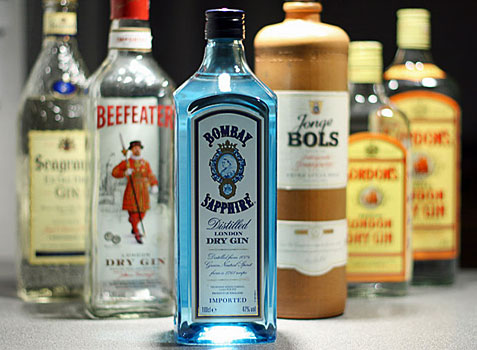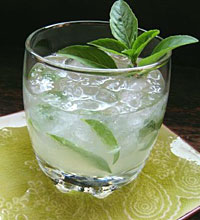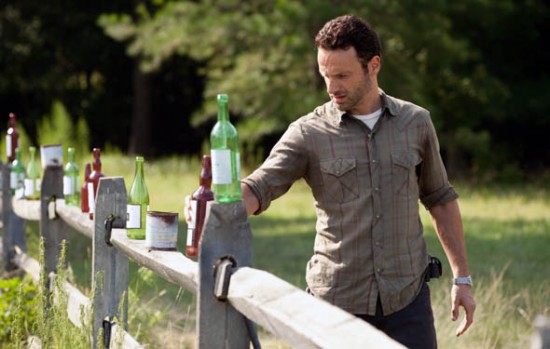Spotlight on Booze: Gin
Posted by Bob Westal (11/28/2011 @ 5:58 pm)

It’s lost some commercial ground to vodka over the decades, but the revival of interest in classic cocktails has given gin a boost lately. In any case, this venerable liquor remains the standard clear alcohol among serious cocktail aficionados, who strongly prefer its more complex flavor and swear it’s the only true main ingredient in a martini.
 Gin is distilled from grain, usually wheat or rye, and starts out as a fairly plain spirit probably not so different from vodka. After that, “distilled gins” are then distilled a second time with various flavorings. The most prominent being juniper berries. That’s only for starters, as gin manufacturers use a pretty vast assortment of herbs and other botanicals ranging from licorice root to grapefruit peels to the perfumey bergamot we associate with Earl Grey tea. Some ultra-cheap brands are “compound gins.” These gins are not redistilled, but simply have tiny infusions added — they’re basically gin-flavored alcohol.
Gin is distilled from grain, usually wheat or rye, and starts out as a fairly plain spirit probably not so different from vodka. After that, “distilled gins” are then distilled a second time with various flavorings. The most prominent being juniper berries. That’s only for starters, as gin manufacturers use a pretty vast assortment of herbs and other botanicals ranging from licorice root to grapefruit peels to the perfumey bergamot we associate with Earl Grey tea. Some ultra-cheap brands are “compound gins.” These gins are not redistilled, but simply have tiny infusions added — they’re basically gin-flavored alcohol.
Most modern gins are “dry” and manufactured in England; these gins legally may not contain any added sugar and that aids in the liquor’s superb mixability. As far as we can tell, however, there isn’t much predictable difference between “London dry, “extra dry,” and other similar designations. “Plymouth” gins technically only have to come from the coastal town, but they tend to have a somewhat more complex, pungent, and slightly sweeter flavor profile. Largely produced in Holland and Belgium, genever is a less strong gin variant popular in central Europe. With plenty of added sugar, you can still find very sweet “old Tom” gin if you look hard. Speaking of sweet, you’ve likely had a slurp or two or of “sloe gin,” actually a liqueur made with gin or cheaper neutral spirits mixed with sloe berries. Most brands of gin are between 84 and 92 proof (42-46 percent alcohol), but a number of less upscale mass market brands are available at 80 proof or even less.
Like all types of booze, gin is available in a number of price levels, but there’s not really any such thing as a super premium gin. While you can easily spend $150.00 or much more on a bottle of small batch bourbon or single malt Scotch, if you find a bottle of regular size bottle of gin selling for more than $50.00, you’re probably paying mostly for ultra-fancy packaging. Some of the best and/or most popular premium gins include Tanqueray Ten, Plymouth (a brand as well as style of gin), and Bombay Sapphire. Just as good or better, in our opinion, are the mid-priced premiums, available in some states at discounters like Costco, Bev-Mo and Trader Joe’s. These include Tanqueray, Bombay Dry Gin (less heavy on the perfumey juniper berries than Sapphire), and Hendricks, an increasingly popular Scottish gin we like quite a bit. A bit cheaper, still quite good, and very rich in “Mad Men”-style classic street cred, is Beefeater.
Read the rest of this entry »
Posted in: Food & Drink, Lifestyle, Vices
Tags: bath tub gin, Beefeater, Bombay Dry Gin, Bombay Sapphire, booze, Casino Royale, compound gin, distilled gin, Dr. Franciscus de la Boe, gin, gin brands, gin cocktail, gin history, Glorious Revolution, Gordon's Gin, Hendrick's, liquor, London dry, mad men, mixology, old Tom gin, Plymouth, sloe gin, spirits, Tanqueray Ten, Turpentine, Vesper, William of Orange
Cyber Monday!
Posted by Bullz-Eye Staff (11/28/2011 @ 10:06 am)

We posted our Holiday Gift Guide last week just in time for Black Friday and Cyber Monday. It’s broken down into categories like Gadgets, Movies, TV, For Her, Games, Guy Stuff and For the Home. Browse through the sections and you’ll find some great gift ideas.
With Cyber Monday there are loads of deals out there. Check out the deals at Amazon.com for a variety of gift ideas.
Posted in: Gadgets, Stuff to Buy
Tags: 2011 holiday gift guide, Black Friday, Cyber Monday, Gadget gifts, gift guide, gift guide for guys, gift guide for men, gifts for her, gifts for the home, guy gifts, Holiday Gift Guide, holiday gift guide for guys, holiday gift guide for men, movie gifts, TV gifts
Will we get an epic Super Bowl?
Posted by Bullz-Eye Staff (11/28/2011 @ 8:24 am)
The NFL has been on a roll. Recent Super Bowls have produced incredible games, unlike a generation ago when it became an annual blowout. After getting past the nasty labor dispute this offseason, the NFL season hasn’t missed a beat, and we might be heading for an epic showdown in the Super Bowl. Just imagine a matchup between the Packers and the Patriots!
First, you have a battle between two quarterbacks who define this era in the NFL. Tom Brady is the current king of the hill with three Super Bowl titles and amazing stats. He led his team to an undefeated season and then suffered his only significant blemish to his resume with a loss to the New York Giants in the Super Bowl. With Aaron Rodgers you have a quarterback who many believe has surpassed Brady as the best of the NFL. Rodgers capped an epic run last season with an incredible performance in the Super Bowl against the Steelers, and now he’s leading the Packers to a potential undefeated season.
Next, you have two high-profile franchises. While being a small-market team, the Packers are one of the legendary franchises in the NFL who reclaimed their glory with a title last season. With New England you have the team that has dominated the past decade behind Bill Belichick, who many consider to be the best coach of his generation.
Finally, you have two teams that represent the modern NFL with the emphasis on scoring over defense. The game has changed as the NFL tried even harder to protect the quarterback. With these changes, guys like Brady and Rodgers have an even easier time, which then translates to huge stats. But fans love offense!
A matchup between these two teams would be an epic event.
Posted in: Sports
Tags: Aaron Rodgers, football betting lines, football lines, football live lines, football odds, football spreads, NFL betting lines, NFL lines, NFL live lines, NFL odds, NFL spreads, Super Bowl, Tom Brady
Is “The Walking Dead” losing its way?
Posted by Jeff Morgan (11/25/2011 @ 7:22 pm)

I went into season two of AMC’s “The Walking Dead” thinking it would be a slam dunk. How could it be anything but? The first season, at just six episodes, was one of the most intriguing pieces of television I’ve seen in years. Most of its allure was the pacing. Every episode had moments of pure calm that were invariably interrupted by drooling hordes of zombies. But the zombies didn’t carry the show. The characters did most of the work, which is exactly what a good zombie show needs. We need to care about the characters so that the inevitable losses have some consequence, a task the writers of the show met head-on. All of this is to say that my expectations, high as they were, were based on the merit of the first season.
Season two started well. The survivors from last season had decided to leave Atlanta and head for Fort Benning. They hit a roadblock on the way out of town, which included a brush with a shuffling horde of zombies. We saw a pair of walkers dispatched, the first with a screwdriver through the eye, the second with a quick stab to the brainstem. It was a perfect re-introduction to the gruesome, post-apocalyptic world I loved in season one.
While creative zombie-killing is great, it isn’t enough to carry the show. There has to be some sort of plot. For season one, it was getting into Atlanta and the CDC with the hope of finding more survivors. In season two we have Fort Benning, again with the hope of finding survivors. It’s a fine plot, though it does get quickly derailed when Sophia, one of the children in the group, is chased into the woods and later disappears. Sophia’s disappearance would have been fine had it been contained to just an episode or two, but it has utterly consumed the show. Read the rest of this entry »
Drink of the Week: Spike Your Juice (Federweisser)
Posted by Bob Westal (11/25/2011 @ 5:00 pm)
 Today we have something a bit different that feels kind of homey and appropriate for Thanksgiving weekend, even if it’s got a European pedigree. Home fermented grape juice, apparently known in Germany as Federweisser, isn’t exactly a cocktail, but then it’s U.S. cousin, Spike Your Juice, doesn’t exactly produce wine. The good news is that what it does produce is a tastier and much more fun alternative to a wine cooler or some ghastly “malt beverage.”
Today we have something a bit different that feels kind of homey and appropriate for Thanksgiving weekend, even if it’s got a European pedigree. Home fermented grape juice, apparently known in Germany as Federweisser, isn’t exactly a cocktail, but then it’s U.S. cousin, Spike Your Juice, doesn’t exactly produce wine. The good news is that what it does produce is a tastier and much more fun alternative to a wine cooler or some ghastly “malt beverage.”
What I got in the mail from the Spike Your Juice people was a glass sealer that fits inside a plastic stopper and a number of thin tubey-envelopes which, in turn, contain primarily yeast, the friendly microorganism that turns fattening fructose into equally fattening, but somewhat more dangerously interesting, alcohol. All you do is empty the powdery contents of the tubes into a 64 ounce juice container — they suggest grape juice or other purplish/reddish beverages mentioned in a link at their faq. You don’t shake it or do anything else to it at all.
You then attach the aforementioned glass tubes (to which you have added some water) and plastic thingy to the top of the container, being careful to permanently discard the original bottle cap. That’s important because, apparently, from this point on, anything remotely airtight can result in a messy explosion that could leave you standing in the purple rain.
Next, you leave the unrefrigerated bottle alone for 48 hours; you’ll see a bit of foaming and an occasional bubble in the water in the glass tubing. When the time has passed, you are supposed to sample the result and, if it’s too sweet for you, reattach the apparatus. Once you’re happy with what what you’ve got, you then leave only the plastic portion in place, which means your drink is partially exposed and won’t be holding onto it’s fizz for long.
At the 48 hour point, what I had was a rather delightful but very sweet fizzy beverage that isn’t at all like the bad sparkling wine you might expect, but is like a really very nice slightly alcoholic lightly carbonated grape juice. Still, it was very sweet and packed little punch so I let the fermentation continue. Although I like the drier version just fine over ice, I’m slightly embarrassed to admit that I wish I had stopped at maybe 55 or 60 hours, rather than 72. That’s my old sweet tooth again.
It’s not one of the suggested juices and I’m curious why, but, I’m going to try this with apple juice. I love hard apple cider, the original Euro-American booze beloved of our pilgrim predecessors…and I guess that covers the need for a Thanksgiving weekend reference to wrap this post up.
Posted in: Food & Drink, Lifestyle, Vices
Tags: apple cider, cocktails, Drink of the Week, Federweisser, grape juice, Happy Hour, pilgrims, Spike Your Juice, Thanksgiving, Thanksgiving weekend, Welch's Grape Juice
 Gin is distilled from grain, usually wheat or rye, and starts out as a fairly plain spirit probably not so different from vodka. After that, “distilled gins” are then distilled a second time with various flavorings. The most prominent being juniper berries. That’s only for starters, as gin manufacturers use a pretty vast assortment of herbs and other botanicals ranging from licorice root to grapefruit peels to the perfumey bergamot we associate with Earl Grey tea. Some ultra-cheap brands are “compound gins.” These gins are not redistilled, but simply have tiny infusions added — they’re basically gin-flavored alcohol.
Gin is distilled from grain, usually wheat or rye, and starts out as a fairly plain spirit probably not so different from vodka. After that, “distilled gins” are then distilled a second time with various flavorings. The most prominent being juniper berries. That’s only for starters, as gin manufacturers use a pretty vast assortment of herbs and other botanicals ranging from licorice root to grapefruit peels to the perfumey bergamot we associate with Earl Grey tea. Some ultra-cheap brands are “compound gins.” These gins are not redistilled, but simply have tiny infusions added — they’re basically gin-flavored alcohol.



 Today we have something a bit different that feels kind of homey and appropriate for Thanksgiving weekend, even if it’s got a European pedigree. Home fermented grape juice, apparently known in Germany as Federweisser, isn’t exactly a
Today we have something a bit different that feels kind of homey and appropriate for Thanksgiving weekend, even if it’s got a European pedigree. Home fermented grape juice, apparently known in Germany as Federweisser, isn’t exactly a 








